 Hartlepool Sports & Leisure
Hartlepool Sports & Leisure
- Cinemas, Theatres & Dance Halls
- Musicians & Bands
- At the Seaside
- Parks & Gardens
- Caravans & Camping
- Sport
 Hartlepool Transport
Hartlepool Transport
- Airfields & Aircraft
- Railways
- Buses & Commercial Vehicles
- Cars & Motorbikes
- The Ferry
- Horse drawn vehicles
 A Potted History Of Hartlepool
A Potted History Of Hartlepool
- Unidentified images
- Sources of information
- Archaeology & Ancient History
- Local Government
- Printed Notices & Papers
- Aerial Photographs
- Events, Visitors & VIPs
 Hartlepool Trade & Industry
Hartlepool Trade & Industry
- Trade Fairs
- Local businesses
- Iron & Steel
- Shops & Shopping
- Fishing industry
- Farming & Rural Landscape
- Pubs, Clubs & Hotels
 Hartlepool Health & Education
Hartlepool Health & Education
- Schools & Colleges
- Hospitals & Workhouses
- Public Health & Utilities
- Ambulance Service
- Police Services
- Fire Services
 Hartlepool People
Hartlepool People
 Hartlepool Places
Hartlepool Places
 Hartlepool at War
Hartlepool at War
 Hartlepool Ships & Shipping
Hartlepool Ships & Shipping

Lifeboats & Lifesaving at Seaton
Details about Lifeboats & Lifesaving At Seaton
Lifeboats, Lifesaving and shipwrecks at Seaton Carew.
Location
Related items :
 Henry Hood and wife Mary
Henry Hood and wife Mary
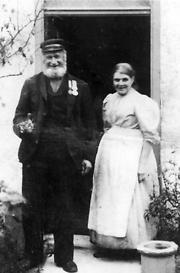 Donated by Maureen Anderson
Donated by Maureen AndersonHenry Hood, coxswain, with his wife Mary (nee Brownbridge born 1833 died 1909) outside their cottage at Southend. They were married in 1857.
More detail » Henry Hood coxswain (1)
Henry Hood coxswain (1)
 Donated by Douglas Ferriday
Donated by Douglas FerridayPart of the Hartlepool Library Service collection
Henry Chilton Hood followed his father, William, and his brother, Robert, by becoming coxswain of the Seaton Carew lifeboats in August 1867. He remained in this role for thirty-one years until his retirement in 1898. He died in 1913 aged 80.
More detail » Henry Hood coxswain (2)
Henry Hood coxswain (2)
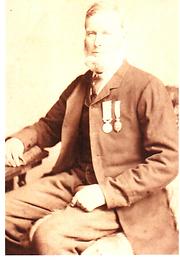 Donated by Maureen Anderson
Donated by Maureen AndersonHenry wearing his medals. In March 1883 he and his crew went to the assistance of the schooner Atlas when she ran aground on Longscar Rocks. Henry and John and Matthew Franklin were awarded the RNLI Silver medal for their bravery. Queen Victoria also conferred the Albert Medal second class on Henry for his part in the rescue. On his retirement he was voted a second silver clasp to his Silver Medal.
More detail » Henry Hood lifesaving medal
Henry Hood lifesaving medal
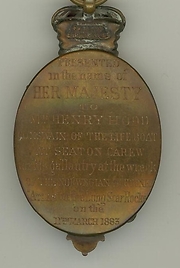 Donated by Maureen Anderson
Donated by Maureen AndersonIn about 2010 the medals awarded to Henry Hood for assisting in the rescue of the crew of the Atlas wrecked on Longscar Rocks at Seaton Carew in March 1883 were found in a descendant's loft. They were donated to Hartlepool Museums and are now exhibited in the Maritime Museum. This is the Albert Medal awarded by Queen Victoria in 1883 for his part in the rescue of the crew of the schooner Atlas.
More detail » In front of the Low Light
In front of the Low Light
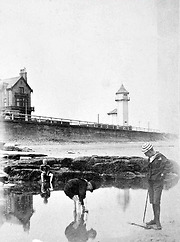 Created by James Whitehead Pattison
Donated by Bowes Museum, Barnard Castle, County Durham
Created by James Whitehead Pattison
Donated by Bowes Museum, Barnard Castle, County DurhamPart of the Pattison's Photographs collection
Dated 1888
Cooper and his two friends play in a pool on the beach. Staincliffe Villa and the lowlight stand above them.
More detail » Lifeboat Tees and Jessie Stevens
Lifeboat Tees and Jessie Stevens
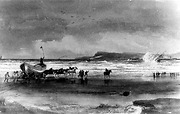 Created by Unknown
Donated by Bowes Museum, Barnard Castle, County Durham
Created by Unknown
Donated by Bowes Museum, Barnard Castle, County DurhamPart of the Part of the Pattison's Photographs collection
Dated 1849
From what was probably a drawing; The first Seaton lifeboat Tees goes to the aid of the Jessie Stevens near Teesmouth in 1849. She was in tow by the tug Reaper when the tow-rope broke and she went ashore on the North Gare. The crew of four were saved 'with great difficulty'. The Tees lifeboat was in service from 1824 to 1857 and was instrumental in saving at least 188 lives.
More detail » Lifeboat practice
Lifeboat practice
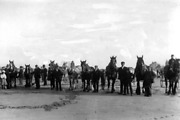 Created by James Whitehead Pattison
Donated by Bowes Museum, Barnard Castle, County Durham
Created by James Whitehead Pattison
Donated by Bowes Museum, Barnard Castle, County DurhamPart of the Part of the Pattison's Photographs collection
Dated 1888
Horses lined up on Seaton Beach for lifeboat practice. In the early days this was done four times a year.
More detail » R.N.L.I. Seaton motor lifeboat Bradford
R.N.L.I. Seaton motor lifeboat Bradford
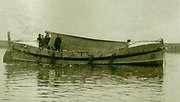 Donated by Maureen Anderson
Donated by Maureen AndersonDated 1907
In 1907 the motor lifeboat Bradford was stationed at the Snook. The lifeboatmen found it difficult to convert from rowing to motorised. She proved to be expensive as there were many breakdowns. Also a watchman had to be employed to look after the boat and her tackle. It was removed in 1909.
More detail » R.N.L.I. lifeboat Charlotte (1)
R.N.L.I. lifeboat Charlotte (1)
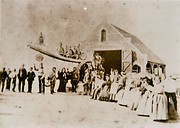 Created by unknown
Donated by Maureen Anderson
Created by unknown
Donated by Maureen AndersonDated 1857
The first Seaton lifeboat was the Tees donated by Thomas Backhouse in about 1824. In 1857 Seaton joined the RNLI and a new boat, Charlotte, was placed there. Here she is on her launching carriage outside the new boathouse built in October 1857. She was in service until 1867 when she was replaced by a boat of the same name which was in service until 1873. These two lifeboats were instrumental in saving 65 lives between them.
HHT&N 692
More detail » R.N.L.I. lifeboat Charlotte 2
R.N.L.I. lifeboat Charlotte 2
 Created by Unknown
Donated by Maureen Anderson
Created by Unknown
Donated by Maureen AndersonDated 1867
An inspection of the new Seaton lifeboat Charlotte in 1867 which replaced the boat of the same name
More detail » R.N.L.I. lifeboat Francis Whitbourn & crew - 1908
R.N.L.I. lifeboat Francis Whitbourn & crew - 1908
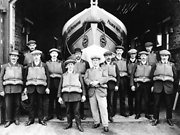 Donated by Mr. Paul Colin Hodgson
Donated by Mr. Paul Colin HodgsonDated 1906
The crew of the Seaton Carew Lifeboat Francis Whitbourn gathered at the Lifeboat House in 1908. The Station closed in 1922.
HHT&N 695
More detail » R.N.L.I. lifeboat Francis Whitbourn (1)
R.N.L.I. lifeboat Francis Whitbourn (1)
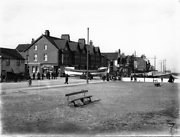 Donated by Maureen Anderson
Donated by Maureen AndersonDated 1908
The RNLI Seaton lifeboat Francis Whitbourn being hauled towards the beach for a practice launch in 1908. She was donated by Robert Lodge and had cost £802. She was in use from January 1908 until April 1922 when the lifeboat station at Seaton ceased to be. In this time she was instrumental in saving 21 lives.
HHT&N 547
More detail » R.N.L.I. lifeboat Francis Whitbourn (3)
R.N.L.I. lifeboat Francis Whitbourn (3)
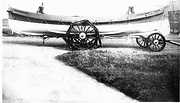 Donated by Mr R Williams
Donated by Mr R WilliamsPart of the Hartlepool Library collection
Dated 1908
 R.N.L.I. lifeboat John Lawson (1)
R.N.L.I. lifeboat John Lawson (1)
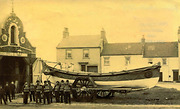 Donated by Maureen Anderson
Donated by Maureen AndersonDated 1888
Henry Hood and seven members of the crew with the RNLI Seaton lifeboat John Lawson on her launching carriage outside the lifeboat house at the southern end of Seaton Carew.
More detail » R.N.L.I. lifeboat John Lawson (2)
R.N.L.I. lifeboat John Lawson (2)
 Created by James Whitehead Pattison
Donated by Bowes Museum, Barnard Castle, County Durham
Created by James Whitehead Pattison
Donated by Bowes Museum, Barnard Castle, County DurhamPart of the Pattison's Photographs collection
Dated 1888
The naming ceremony of the lifeboat John Lawson on the Green in May 1888. The christening was carried out by Margaret Lawson, daughter of the vicar after whom the boat was named, and James W Pattison invoked a blessing.
More detail » R.N.L.I. lifeboat John Lawson (3)
R.N.L.I. lifeboat John Lawson (3)
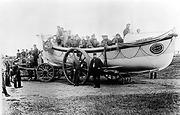 Created by James Whitehead Pattison
Donated by Bowes Museum, Barnard Castle, County Durham
Created by James Whitehead Pattison
Donated by Bowes Museum, Barnard Castle, County DurhamPart of the Pattison's Photographs collection
Dated 1888
The John Lawson on her carriage at her naming ceremony on The Green, Seaton Carew in May 1888. Henry Hood, coxswain, has his arm on the nearside of the boat & next to him is Robert Robinson. All the crew are wearing their cork life-jackets.
More detail » R.N.L.I. lifeboat John Lawson (4)
R.N.L.I. lifeboat John Lawson (4)
 Created by unknown
Donated by Hartlepool Library Service
Created by unknown
Donated by Hartlepool Library ServiceR.N.L.I. Lifeboat John Lawson being towed to the sea at Seaton Carew by horses.
HHT&N 694
More detail » R.N.L.I. lifeboat John Lawson and crew
R.N.L.I. lifeboat John Lawson and crew
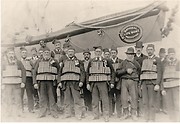 Donated by Mr Paul Colin Hodgson
Donated by Mr Paul Colin HodgsonThis photo was probably taken on the day of the naming of the John Lawson in 1888. Along the front row the first man proudly sporting medals is John Henry Franklin then Henry Hood and next to him is Matthew Franklin. The medals were received for their services to the Atlas in 1883. Second from the end of the row, wearing a cork life jacket, is George Hodgson.
More detail » R.N.L.I. lifeboat John Lawson and the Granite
R.N.L.I. lifeboat John Lawson and the Granite
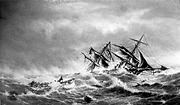 Donated by Maureen Anderson
Donated by Maureen AndersonOn 12th December 1888 the John Lawson lifeboat went on its first mission to the West Hartlepool owned ship Granite. Sadly all eight of the crew of the Granite perished and the ship was wrecked. The crew of the lifeboat consisted of; Henry, Robert and William Hood, Robert Robinson, J Kendall, Thomas Blekinsop, F Kitson, William Proctor, Matthew Franklin, W Harrison and R Burton.
More detail » Rocket House
Rocket House
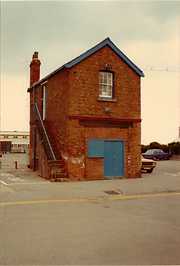 Donated by Hartlepool Library Services
Donated by Hartlepool Library ServicesPart of the Hartlepool Library collection
The building was originally erected to store the equipment needed to save life at sea by the means of rocket lines. It saw service as a part time police station around the 1980s and was being used as a first aid post when this photo was taken. Longscar Hall can be seen to the rear.
hht&n 2039
More detail » Rocket practice
Rocket practice
 Created by James Whitehead Pattison
Donated by Bowes Museum, Barnard Castle, County Durham
Created by James Whitehead Pattison
Donated by Bowes Museum, Barnard Castle, County DurhamPart of the Part of the Pattison's Photographs collection
Dated 1888
A small crowd watches the rocket practice beside the golf clubhouse in Seaton Carew.
More detail » Rocket practice
Rocket practice
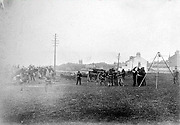 Created by James Whitehead Pattison
Donated by Bowes Museum, Barnard Castle, County Durham
Created by James Whitehead Pattison
Donated by Bowes Museum, Barnard Castle, County DurhamPart of the Pattison's Photographs collection
Dated 1888
A small crowd watches rocket practice at Seaton Carew in 1888. This was a means of saving life from shipwreck by firing lines. The lines could be secured on a vessel and used either to get a lifeboat closer or to pull those aboard to safety, usually on a cradle.
More detail » Seaton High Light 1
Seaton High Light 1
 Donated by Douglas Ferriday
Donated by Douglas FerridayPart of the Hartlepool Library Collection collection
Dated 1967
THe highlight at Longhill surrounded by the North Steel Works. The light was built in 1839 along with the Low Light at Seaton. One light shone above the other to give double lights as a warning to the vessels out at sea.
If you look behind the lamp post in right-hand side of the image you will see the rising conveyor gallery that carried the iron ore and coke breeze up to the surge bins in the building immediately to the left of the lamp post. The mixed ore and breeze was then conveyed to the building to the left again to be sintered and sent to the nearby blast furnaces of the South Durham Steel and Iron Company.
HHT+N 97
More detail » Seaton High Light 2
Seaton High Light 2
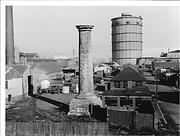 Donated by Douglas Ferriday
Donated by Douglas FerridayPart of the Hartlepool Library Collection collection
Dated 1967
 Seaton High Light 3
Seaton High Light 3
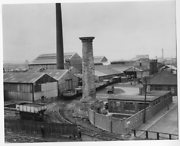 Donated by Hartlepool Museum Service
Donated by Hartlepool Museum ServiceSeaton High Light when it stood in the grounds of Bachelor Robinson.
More detail » Seaton High Light 4
Seaton High Light 4
 Donated by Douglas Ferriday
Donated by Douglas FerridayPart of the Library collection collection
Dated 1967
Close up showing the date of 1839. What remained of the High Light was dismantled and re-erected at Hartlepool Marina.
HHT+N 98
More detail » Seaton High Light 5
Seaton High Light 5
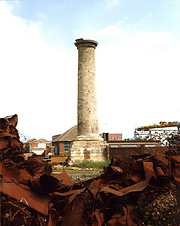 Donated by Hartlepool Library Service
Donated by Hartlepool Library ServiceSeaton High Light after the demise of the Steel Works. The light is now in the grounds of a scrapyard in this picture.
HHT+N 727
More detail » Seaton Low Light (1)
Seaton Low Light (1)
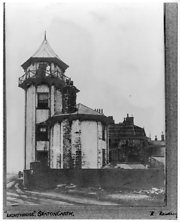 Donated by Hartlepool Museum Service
Donated by Hartlepool Museum ServiceThe Lighthouse was built in 1838/39 on the Cliff above Longscar Rocks. Another lighthouse was erected at the same time at Longhill. Seaton light was known as the lowlight and the Longhill light was known as the highlight. From out at sea one light would shine above the other, warning the mariners of the dangers of the rocks.
More detail » Seaton Low Light (2)
Seaton Low Light (2)
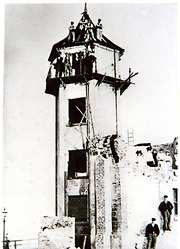 Donated by Douglas Ferriday
Donated by Douglas FerridayPart of the Hartlepool Library Service collection
This image shows the demolition of the lighthouse in 1900. There are certainly no health and safety regulations in place here. Note that there are even five females posing behind the demolished brickwork.
HHT&N 598
More detail » Sketch of Seaton lifeboat
Sketch of Seaton lifeboat
 Created by Northern Daily Mail
Donated by Maureen Anderson
Created by Northern Daily Mail
Donated by Maureen AndersonA sketch of the first Seaton lifeboat Tees on her carriage depicted in an article by William Boagey in the Northern Daily Mail in 1949. This is probably a sketch of a model of the lifeboat.
More detail »




